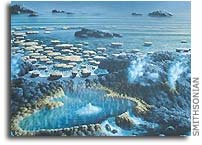Hydrogeologic Controls on Episodic H2 Release from Precambrian Fractured Rocks–Energy for Deep Subsurface Life on Earth and Mars

Astrobiology December 2007, 7(6): 971-986
http://www.liebertonline.com/doi/pdfplus/10.1089/ast.2006.0096
Dissolved H2 concentrations up to the mM range and H2 levels up to 9-58% by volume in the free gas phase are reported for groundwaters at sites in the Precambrian shields of Canada and Finland. Along with previously reported dissolved H2 concentrations up to 7.4 mM for groundwaters from the Witwatersrand Basin, South Africa, these findings indicate that deep Precambrian Shield fracture waters contain some of the highest levels of dissolved H2 ever reported and represent a potentially important energy-rich environment for subsurface microbial life. The 2H isotope signatures of H2 gas from Canada, Finland, and South Africa are consistent with a range of H2-producing water-rock reactions, depending on the geologic setting, which include both serpentinization and radiolysis.
In Canada and Finland, several of the sites are in Archean greenstone belts characterized by ultramafic rocks that have under-gone serpentinization and may be ancient analogues for serpentinite-hosted gases recently reported at the Lost City Hydrothermal Field and other hydrothermal seafloor deposits. The hydrogeologically isolated nature of these fracture-controlled groundwater systems provides a mechanism whereby the products of water-rock interaction accumulate over geologic timescales, which produces correlations between high H2 levels, abiogenic hydrocarbon signatures, and the high salinities and highly altered 18O and 2H values of these groundwaters. A conceptual model is presented that demonstrates how periodic opening of fractures and resultant mixing control the distribution and supply of H2 and support a microbial community of H2-utilizing sulfate reducers and methanogens.








